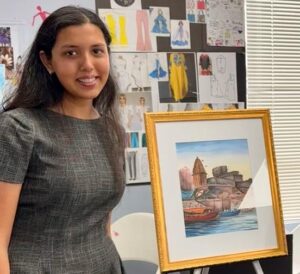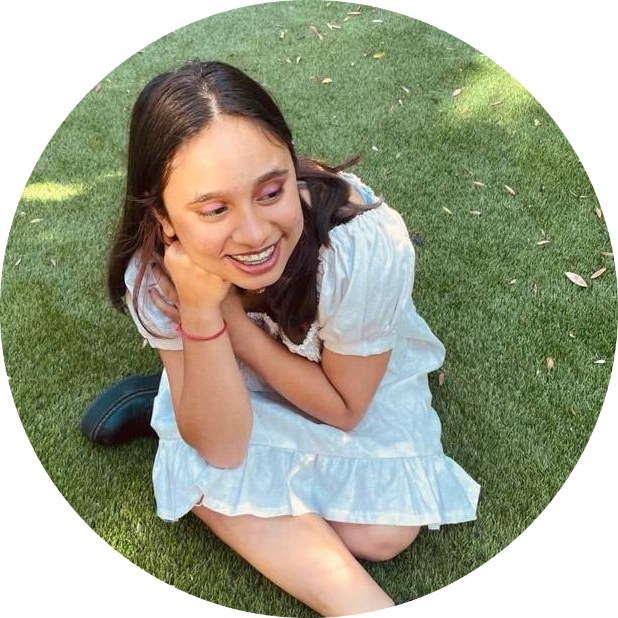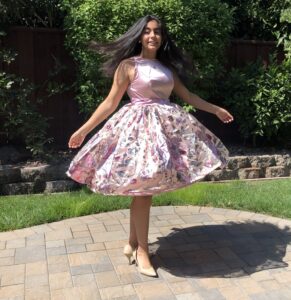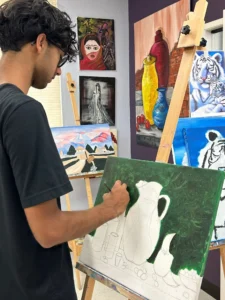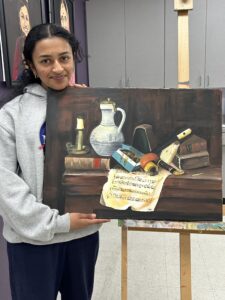“A Lonely Storm”
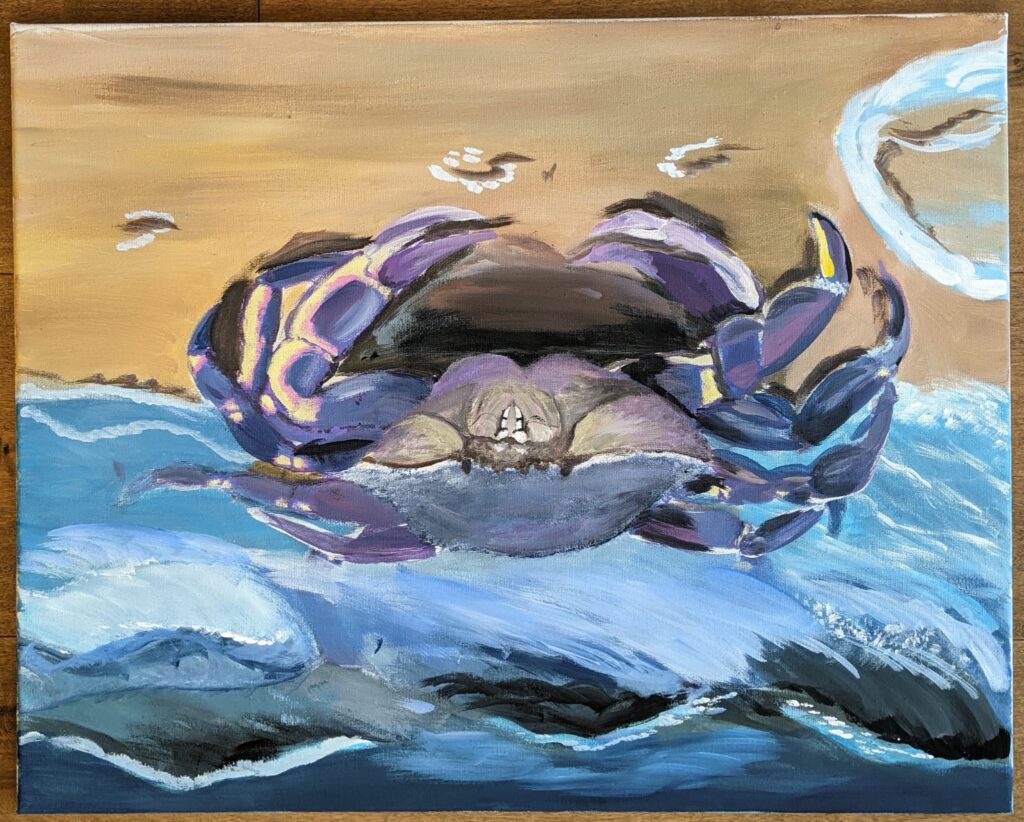
By Zoya Zafer (7th) The Journey of the Graceful Rock Crab The slender crab, also called the graceful rock crab, has a few different names. Its scientific names are Metacarcinus gracilis (used by WoRMS) and Cancer gracilis (used by ITIS). You can find this crab in places like Prince William Sound, Alaska, Sebastian Vizcaino Bay, Baja California, and Mexico. It has a rare purple color and is sometimes found in bays, but other times, it lives deep in the sand and mud—as deep as 174 meters! I chose to paint this crab because I love its purple shade. In my artwork, the crab is standing on a beach with big waves crashing behind it. The white lines show the foam that forms in the ocean during a storm. The dark blue, black, and white colors in the background make the storm feel intense and powerful. But even with the storm around it, the crab stays strong. I added yellow and pink on its legs to show how special this crab is. It stands in the middle of the painting to show that it is independent and brave. Even when it’s alone, it is still part of its graceful rock crab family. No matter where it is, it belongs. This artwork tells a story—even when things get tough, you can keep going and get through it. #RockCrab #MetacarcinusGracilis #ArtAndNature #StormySeas #StayStrong #KalaArtAndDesign
The Story of an Albacore
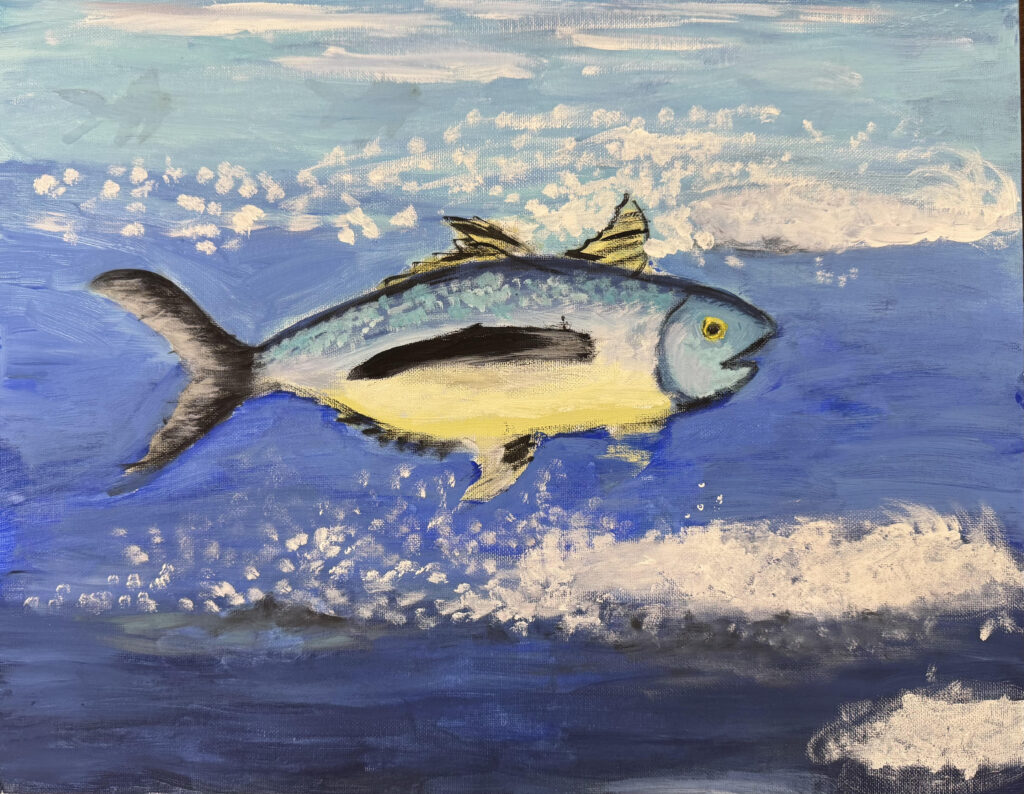
By- Gianna Joe Thoms Grade 2nd I made a painting of an albacore tuna swimming in my Kalaa Art & Design Studio. The fish is silver with a dark blue back. It has long fins that help it move fast through the water. I used different shades of blue to show how deep the ocean is. The top of the ocean is bright blue and the bottom is dark blue. Light shines through the waves, making the fish sparkle. The tuna looks smooth and shiny, like it is really swimming. Tiny bubbles float behind the tuna as it moves. In the background, there might be other sea creatures. Maybe there are little fish swimming nearby or a big shark far away. The water looks like it’s moving with soft waves. The painting shows how the ocean is full of life. The painting makes me feel like I am in the ocean swimming next to the fish. The colors are bright and pretty. The fish looks strong and free moving fast through the deep blue water. The ocean is big and full of amazing creatures. This painting shows how beautiful and special the albacore tuna is. It is a wonderful fish that belongs in the wild sea!
Truly magnificent; Tiger Rockfish
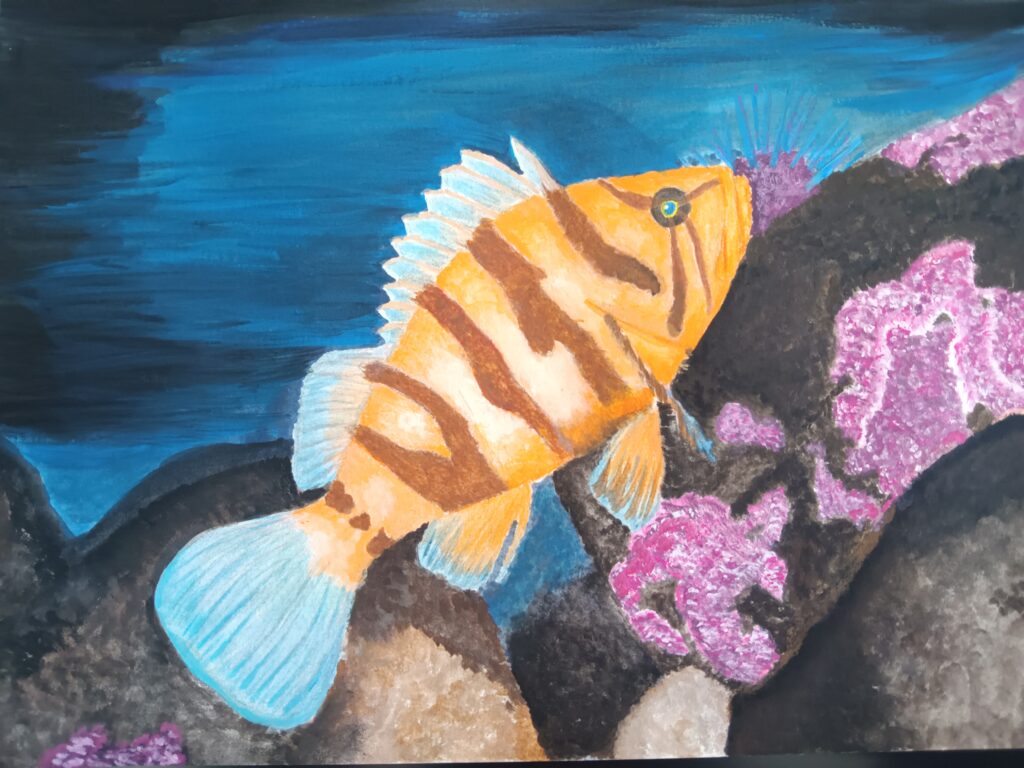
Rianna Shah Grade:8 The ocean is full of incredible creatures, but the tiger rockfish stands out as one of the most beautiful. The vibrant orange and brown stripes make the fish look fierce and elegant. Not only the fish but, its habitat is also just as beautiful, such as the vibrant and rocky reefs. In my artwork, I depicted this by portraying the dark rocks in the background of the fish, along with showing off the vibrant pink plantation around the fish. As I was selecting my artwork for this piece, I wanted a fish that was not only visually stunning but also unique, and the tiger rockfish was the perfect choice. I tried to capture its beauty by showing off the bold brown stripes and elegant orange body. This fish doesn’t blend into its surroundings as its vivid color scheme makes this fish stand out. The fins and spine on this fish, make the rockfish look truly majestic as it glides through the ocean floor. I love how the ocean is dark yet vibrant where this fish lives, and I displayed this stunning scene with a blend of black and blue paint. The Tiger Rockfish is truly magnificent, not just its beauty but also its gorgeous habitat in which it lives. This fish was truly an inspiration for me to paint, and through my art, I hope to capture the uniqueness of this exquisite fish. The world is full of beautiful creatures however, the tiger rockfish will always be one of the most beautiful. Inspiration : Ocean Light.com
Madhubani; Tradition Takes Flight
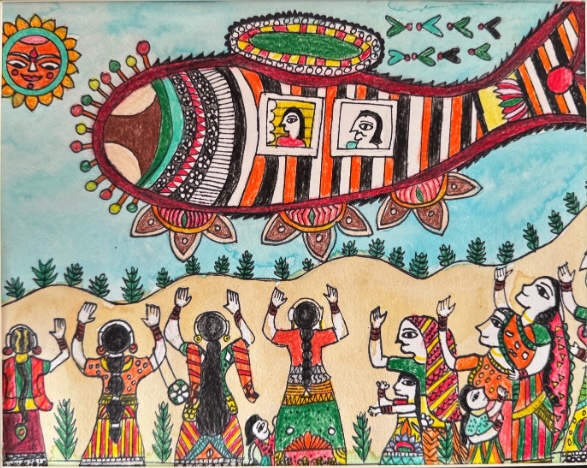
By: Pragna Gowdra Grade 8, Kalaa Studio A Journey Through Art: The Flying Fish of Imagination Created at Kalaa Studio, this artwork feels like a glimpse into a magical world, where tradition and fantasy come together. At the heart of the piece is a giant, flying fish-shaped vehicle, soaring through the sky with two people peering out from its windows. The fish is decorated with bright stripes and intricate patterns, outlined in bold black lines that make every detail pop. The vibrant colors—orange, green, and yellow—bring the scene to life, bursting with energy and excitement. Inspired by Madhubani art, a traditional Indian folk style known for its flat, colorful designs and natural plant-based dyes, this piece captures the essence of cultural storytelling. There’s no shading, just bold, two-dimensional patterns, much like illustrations in a book. For me, this artwork is about adventure and imagination. In Madhubani art, fish symbolize good luck and life, but here, the fish flies, representing the thrill of exploring new places. Below, a group of villagers dressed in traditional Indian attire stand with their hands raised—perhaps waving goodbye or cheering with excitement. A smiling sun with a human face watches over them, adding warmth and connection to the scene. This piece tells a story of a village coming together, either to send off loved ones or to share a message with their leaders. It blends heritage with fantasy, showing that even the most traditional stories can take flight in new and unexpected ways. #ArtAtKalaaStudio #MadhubaniArt #FlyingFish #FolkArtMagic #ImaginationInArt #KalaArtAndDesign
The healing power of art

“The arts are a critical component of healthcare. Expressive art is a tool to explore, develop, and practice creativity as a means to wellness.” ~ Wellarts Association ART has the power to heal, inspire, provoke, challenge & offer hope. ART enhances individuals, society, and the environment. Decades of research have provided more than a sufficient amount of data to prove that arts education impacts everything from overall academic achievement to social and emotional development and so much more. Research has proven the arts develop neural systems that produce a broad spectrum of benefits ranging from fine motor skills to creativity and improved emotional balance Every time you engage in a new or complex activity, your brain creates new connections between brain cells. Your brain’s ability to grow connections and change throughout your lifetime is called brain plasticity or neuroplasticity. Creating art stimulates communication between various parts of the brain. And this is the mere reason why art is important in our daily lives. Art and design process makes life worthwhile. It may not be vital to fulfill our basic needs, but it does make life joyful.
Harmonious Canvas’ Fusion of My Passions
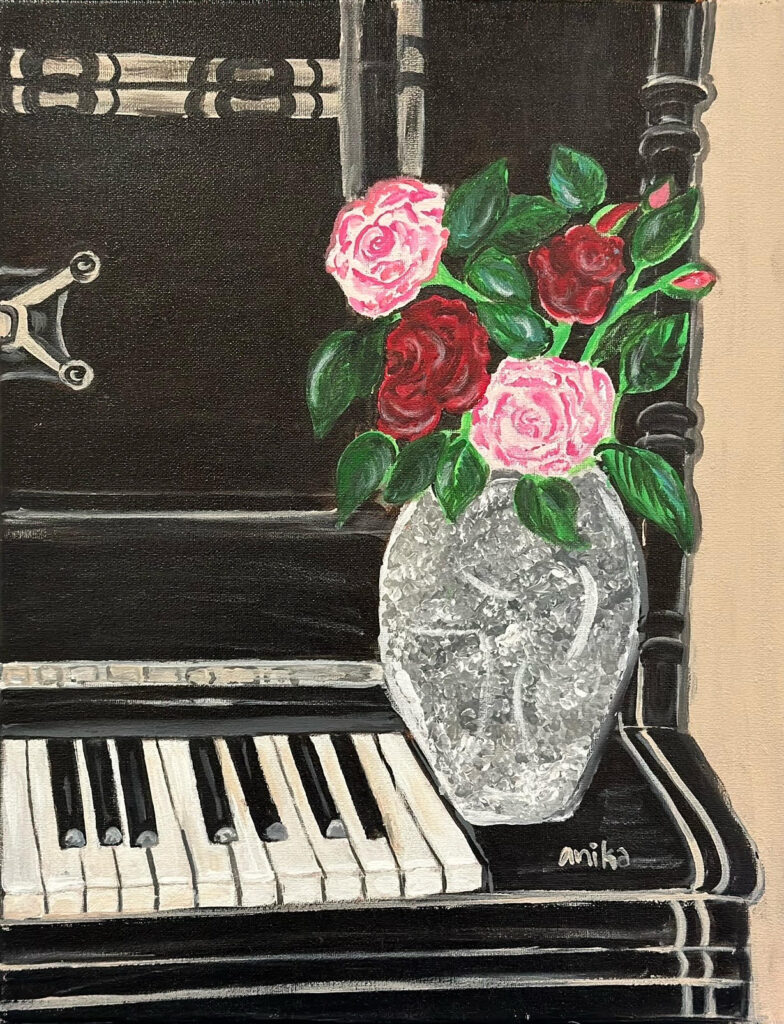
By- Anika Shiroor, 7th grade There are two major influences in my life which started early on – art and piano. For this blog, I want to present Piano, Still-Art on canvas which I painted in 2020. Not only was this the first canvas I painted, but this was also the piece where both my passions intersected. Ever since I was a little girl, I remember my fascination for drawing. I would fill pages and pages in books or draw on boards in my room. I would draw and write stories to express myself. I had a couple of friends who were interested in art, just like me and we would collaborate on stories with art together. I have lost a lot of that work but some of them were preserved by my mom as digital memories on Instagram and Youtube. When I turned five, my parents enrolled me in piano lessons which were super fun thanks to my teacher, Ms. Elena. She made piano effortless and with time I prepared for the Certificate of Merit exams that are held every year by the Music Teachers’ Association of California with her help. I completed level 5 this year. These creative fields have impacted me immensely and both piano and art hold a special place in my heart. In my opinion, these are the nicest ways to express yourself. In 2020, my art teacher, Ms Nidhi announced that we were ready to paint our first canvas art. When I heard that we could choose our own subject I immediately went online to find ideas. While searching for ideas I came across this piano painting online. I knew right then, that I would do this painting because of my love for the piano. This canvas painting combines the luxury of a piano with the beauty of roses. Even though it was a little tough for me back then, I discussed it with my teacher and set on to do this piece. This artwork was created with acrylic paints over a span of a few weeks. I first had to sketch it out and practice it in my art book to ensure that I was familiar with everything in the painting. I made a lot of mistakes because this was my very first canvas painting. This was also my first attempt with acrylic paint. As I understood that all my mistakes in the painting could be covered up by adding more paint, I got impatient with the process. Very soon I realized, that this impatient mindset made my work even worse. With a lot of encouragement from my teacher and correction, I was finally able to complete this artwork. Of course, I was super happy with it as this was my first artwork on canvas even though it had a lot of corrections. The lesson that I learned was that the best results came out when I was patient with the process. I also realized that in my hurry to complete the work, I often rushed and that resulted in a lot of feedback from my teacher both in technique and finish. This canvas is presently hanging on my bedroom wall as a reminder of the process of learning and my continued efforts in art.
Why do I Matter, coz I believe
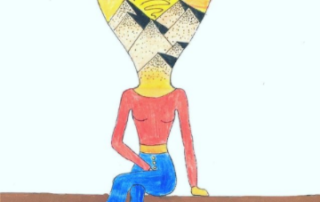
By- Aditi Manchanda, Grade 8 This is my artwork from the Virtual Reflections Art Competition that was held during the month of October. The theme for this contest was “Why do I Matter”. The first thing that I did was make the head into a light bulb. This is the main portion of the focus of the topic “Why do I Matter”. I matter because I want to grow up and share my ideas with the world to make it a better place. This part of my art represents my ideas. One idea that I would like to spread awareness about equality. There are so many people in this world who get discriminated against because of the color of their skin, or their religion, or even because of their gender. They don’t get many opportunities that others do just because of their appearance or what they believe in. Because of all of this commotion, there are so many innocent people who get harmed. There is so much violence, protesting, and war especially with all the riots and chaos in 2020. This is why inside of the light bulb I wrote the word peace and made some scenery around it. I chose to make this piece because I love to draw fashion figures and wanted to incorporate that into my artwork. I made this figure sitting down with a red top and blue jeans. This part of my art represents me. I used colored pencils and a black pen (to trace) to complete my artwork. If used by themselves, colored pencils are used in two techniques – layering and burnishing. Layering is a technique usually used at the beginning of the drawing. Its idea is to use primary colors in layers and with that to get different tones. Burnishing is done on layers and for that is used a colorless blender or a light-colored pencil. For my artwork I used layering. I used this technique for the background in my light bulb. I just used one layer of color for the skin, clothes, and the mountains of my picture. Finally, I used brown paint to make the ledge that my figure is sitting on. The paint I used was acrylic. I hope that this was informative and encouraged you to support causes to make the world a better place. Thank you! — Aditi Manchanda Grade 8
Mumma Bear;Shading Techniques
By Saira Siraj, 7th Grade The first artwork (of the two that I will be talking about) that we did is a shading techniques page. Here we have 4 different ways to shade in a drawing, shading, scumbling, stippling, and hatching. I first made a 16by16 grid towards the bottom of the page. Then we drew two long rectangles, on the top of the page. In the first one, we made lines inside, making equal parts. Then we shaded the rectangle from lightest to darkest. Then below that, we made the same scale but as a gradient, this time with no partitions. In the 16by16 grid on the bottom half of the page, we made columns of different shapes, spheres, cubes, cylinders, and cones. We shaded each row with a different technique. Hatching, Scumbling, Stippling, and Shading. Scumbling was the easiest as it was like scribbling and Stippling took the longest because you have to be very careful with the dots and make sure they don’t look like lines. Hatching, Scumbling, and even Cross Hatching, all are similar because, to make the value darker, you need to make the lines/scribbles closer together to show the tightness. Our next artwork was a drawing of a mama bear and a baby bear. We were allowed to use any techniques that we wished, so I decided to do shading, as it would not take up as much time and I could still get a good-looking drawing. I started off by sketching the two bears. Then, we shaded the cave and the crevices of the bears really dark.
Village Scene, Warli Art
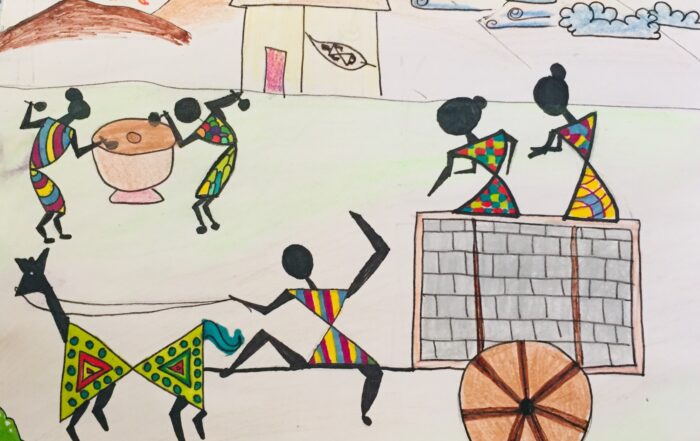
By, Minali Kancharla, Grade 7th The word Warli means a piece of land in the Varli language. Warli is a folk painting style native to India that mostly represents traditional everyday living and special events. The Warli style uses geometrical designs to make the main body of the subjects, this is for humans and animals. Warli painting uses basic shapes such as circles, triangles, and squares. The first step to this art is to sketch out your village scene using a set of basic shapes and make geometric patterns on the dresses. The page was then washed with tonal watercolor, to give a vintage effect. After the water wash on the page dries up, I outlined the sketch with a black point pen. The color scheme chosen for this artwork was Split complimentary, for this I chose two sets of split complementary colors. For each animal or human, use one set of complementary colors to fill the designs inside the subject. The end result is a colorful piece of art made from basic geometric shapes and colors.
Periodt…! periods are not our weaknesses, but our strengths
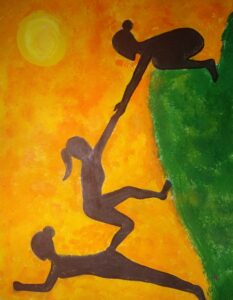
By -Saesha Sharda, Grade 9th When I was a little girl, I was not really encouraged to talk about menstruation, especially in front of my older family members and relatives. Not only was I confused about why periods occur, but also why I wasn’t allowed to talk about it. Now that I’m older and know about periods, I can comfortably talk about them with my parents whenever I have questions or concerns. Menstruation is a fascinating process that happens to almost every single woman on the planet, and I don’t understand why women get shunned for talking about it. Periods are not ‘gross’ or ‘weird’, they’re pretty cool. We need to empower women and encourage them to stand up and talk about light-hearted things like periods, to other heavier topics. My artwork on women empowerment ties into the concept of women helping women. In my artwork, I have shown three women helping each other climb a cliff through a fire. The cliff represents the normal hardships women have to go through, and the fire represents how the outside world makes it harder for women to achieve these tasks. I have used acrylic paint to show a silhouette of the women the background is with acrylic textures. It is important we address things like this through artforms for expressions, I feel it is a step in the right direction. Women are awesome! But, I do understand that the older generation was raised to not talk about women’s’ issues and menstruation, but it is time that changes. Our periods are not our weaknesses, but our strengths; and it’s pretty cool that we get to go through this cycle that perpetuates the entire human species!

